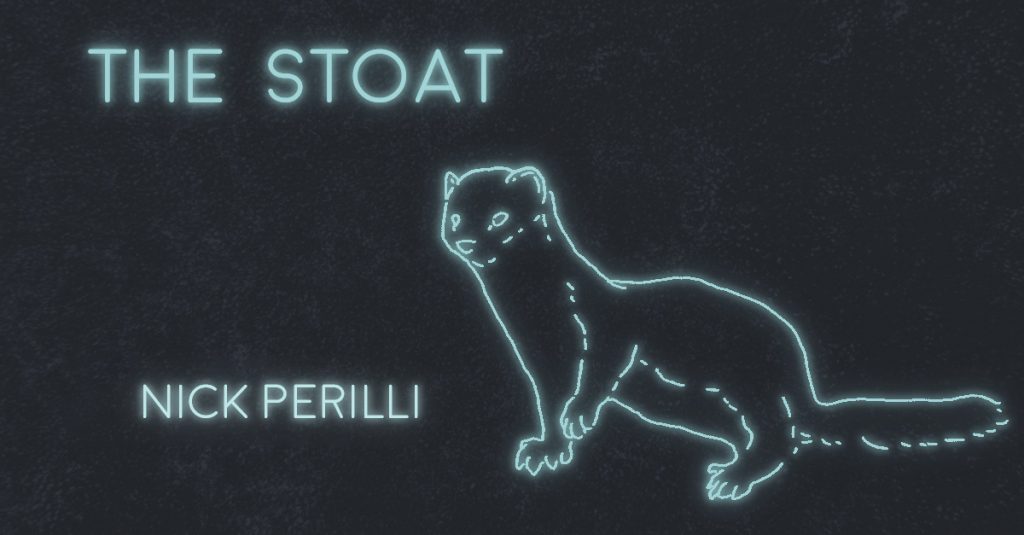We don’t know where the hole in the basement of our house goes, only that it’s far deeper than it looks. Our pet stoat made it last year before disappearing into it. She was always digging—into our wood floors, our garden, our couches, and pantries—but this hole was her masterpiece. The white fur on her belly darkened with dirt over time. Since the day we brought the stoat home, she didn’t pay us any mind; she only had time for digging. She escaped from her cage whenever we weren’t looking, and we admit we rarely looked.
Whatever the stoat was digging for, she must have found it, as we haven’t seen the thing since. Our youngest daughter of three, Aly, sat at the hole in the basement for days while she was home from school with the flu. She, most of all, wanted to follow the stoat wherever it went. To find the better place it had surely gone.
Charles from across the street watched her while she was sick and we were at work. He didn’t have anything else to do but sit in his bedroom on his phone, taking photos of neighbors from the window. Whether it was out of boredom or malice, he encouraged our youngest to search for the stoat.
“Take my phone,” he said, knowing it was at 3 percent. “You can use it as a flashlight.”
At the dinner table that night, we noticed scrapes along Aly’s elbows and some dirt she forgot to wipe away along her neck.
“What happened?” one of us—the angrier one—asked. “Did Charles do this to you?”
Aly hesitated, exploring her options to respond behind her darting eyes, then burst into small tears as she told us that she climbed into the hole in the basement. “And I found her!” she said. “I met the stoat somewhere near the end. I saw an odd light from another place peeking in behind her. She was very still, and her fur had turned all dark.”
She thought the stoat was dead until it shook its head and began cleaning its face with its front paws. It plopped onto its one side, then the other, scrambling like a furred snake. When Aly reached for the stoat, it bit her.
“You’re late,” it said, “but I knew you would follow me.” The stoat’s whiskers twitched. “I’m here to tell you to go right back.”
“What’s there?” Aly asked, looking beyond the stoat. She tried to get closer, but the stoat stood in her way, baring teeth again.
“False wonder and warped danger,” the stoat said. “Dreams of people like Charles up there for children like you.” The stoat barked at her, low and strong like a hungry dog with powerful jaws. It bit Aly again on as many fingers as it could get in its mouth before she pulled away. “It’s not what you need—it’s not what I needed either, I guess, and now I’m caught between these spaces unsure of what to do.”
It barked louder—more guttural, more rabid. Aly backed away.
“I suppose I’ll just stay right here,” the stoat said. “To stop you, your small children, and your children’s small children from ever getting by me. From ever falling victim to predatory wonder. I am prey, but you shouldn’t be.” The stoat snapped its jaws at Aly one more time.
Aly scrambled out of the hole. Charles grabbed her by the arms, begging her to tell him what she saw down there. The false wonder. The warped danger. He had a look in his eye. Aly leaned into him and bit him hard on the neck until he left. Aly said he tasted like pennies—red on her teeth—then pushed the rest of her dinner away. Her older sisters ate it happily.
We called Charles, but he didn’t answer. We still saw the shadow of him in his window across the street taking his pictures, so we knew he was home. In time, the shadow faded.
Over the next three days, we found Aly standing at the top of the basement stairs at three in the morning. She tried and failed to go down the hole a few more times, until she hit a growth spurt and forgot that it was even there. In a decade or two, her children tried. Long after we died and left the house to Aly, her children’s children attempted, then their children—and so on. All of them were bitten and turned away by the same soot-furred stoat.

